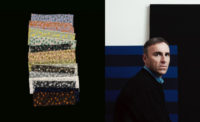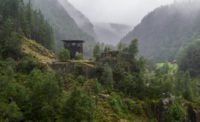Now hear this. For a giant, cochlear band shell called Tubaloon, which hovered over Norway’s annual Kongsberg Jazz Festival this past summer, the designers of Norwegian architecture firm Snøhetta caught an echo from architectural history. Project architect Joshua Teas says his team drew inspiration for Tubaloon from the curving walls and warped twists of the steel-cable-supported Philips Pavilion, which Le Corbusier and Iannis Xenakis created for Brussel’s World Expo of 1958.
But to realize the homage, Snøhetta riffed on an innovative engineering concept developed in 2000 by Swiss engineer Mauro Pedretti. Called Tensairity, Pedretti’s proprietary technology features long-span beams that minimize strut material by using low-pressure air to prevent compression elements from buckling. The basic Tensairity girder, now produced by Pedretti’s Swiss company Airlight, features an air-filled fabric tube connected along the length of a compression element. The tube is then wrapped in two spiraling cables that tie into and strengthen the strut. The effect is a strong strut member with considerably less structural weight and construction time.
In 2003, Ole Gustavsen, who heads Snøhetta’s Oslo office, volunteered his firm’s services to design a band shell for the annual jazz festival, which occurs in a square opposite a recently renovated 242-year-old church in Kongsberg. Teas says a design workshop concluded “with an intuitive sketch of what we thought could suit the space and the festival’s needs nicely—an expressive air-filled shell that we called ‘The Jazz Heart.’ ”
Snøhetta’s architects were acquainted with Tensairity, but had envisioned Tubaloon as entirely inflatable. “At this point, we thought of many more cable stays and support masts than we ultimately ended up with,” Teas notes, adding that achieving their desire for effortless buoyancy frustrated them: “It was going to be tough to get a big, saggy balloon to ‘poing’ up the way we wanted it.” Pedretti, who then came to Oslo, promised that Tensairity would eliminate any need for masts.
Pedretti’s son Andrea engineered the structure. He and Teas adapted the traditional Tensairity girder, substituting a galvanized-steel armature for spiral cables. It is composed of segments with brackets, which the air tubes nestle into. Instead of a by-the-book application of Tensairity, Tubaloon represents “an inflatable, tension-membrane structure in which most of the supporting structure is internalized,” Teas explains. The frame mounts to two poured-concrete foundation pads, with four additional connection points for cables and a compressor that maintains air pressure.
In addition to achieving buoyancy without a forest of masts, the hybrid structure yields other benefits. The air tubes stabilize the steel and provide tension for the polyvinylidene difluoride-coated PVC membrane that drapes over the skeleton, while the segmented steel frame assembles in a matter of days, otherwise storing in simple containers until next year’s three-week-long jazz festival. By day, it’s a visual cymbal crash in the historic context, and at night it is washed in a moody progression of colors that evoke the northern lights.









Post a comment to this article
Report Abusive Comment